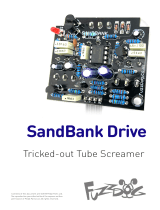Page is loading ...

Graphic Fuzz
Standard power implementation
of the ESR classic fuzz monster
Contents of this document are ©2023 Pedal Parts Ltd.
No reproduction permitted without the express written
permission of Pedal Parts Ltd. All rights reserved.

Before you dig in, ensure you download
and read the General Build Guide.
It contains all the information you need
for a successful outcome.
General
Build
Guide
Your first stop
for build info
Contents of this document are ©2023 Pedal Parts Ltd.
No reproduction permitted without the express written
permission of Pedal Parts Ltd. All rights reserved.

Schematic + BOM
R1 1M
R2 10K
R3 10K
R4 3K3
R5 220R
R6 10K
R7 10K*
C3 100n
C4 100n
C5 1u
C6 1u
C7 47u elec
C9 .47u elec**
C10 .47u elec**
D1 1N5817
IC1 LM741
IC2 LM741*
FILT 1MB
VOL 10KA
NULL 10KB*
The original circuit has far fewer parts than shown above, and
uses a troublesome power arrangement.
This version has been adjusted for standard power, and adds
some basic housekeeping such as input and output caps and
power filtering. It’s also notorious for howling and squealing
when the filter control is turned CW. This is part of the charm and
uniqueness of the pedal, but we’re giving you the option to
mitigate this in several different ways.
*Add R1 so the filter control is never fully open. Use whatever
value you like - we found 10K to be sufficient to cut out the most
extreme squeal. If not using this, jumper it with wire.
You can add a NULL control pot which goes some way to reducing
the squeal. If you don’t like it, take it out! No need for any jumpers
if you don’t want to add it.
Go all-out and add IC2. Stacking the op-amps seems to also work
well in taming the beast. Though not shown on the schematic, the
pins of both ICs are directly connected to each other.
**Changing the value of C9-10 changes the frequency of the
squealing. Original uses 100n, but probably because they were
cheap. Higher value, lower frequency. We like 0.47uf.

PCB layout ©2023 Pedal Parts Ltd.
The power and signal pads on the PCB conform
to the FuzzDog Direct Connection format, so can
be paired with the appropriate daughterboard for
quick and easy offboard wiring. Check the
separate daughterboard document for details.
Be very careful when soldering the diode.
They’re very sensitive to heat. You should use
some kind of heat sink (crocodile clip or reverse
action tweezers) on each leg as you solder them.
Keep exposure to heat to a minimum (under 2
seconds). The same goes for the IC if you aren’t
using a socket.
Snap the small metal tag off the pots so they can
be mounted flush in the box.
You should solder all other board-mounted
components before you solder the pots. Once
they’re in place you’ll have no access to much of
the board. Make sure your pots all line up nicely.

This template is a rough guide only. You should ensure correct marking of your
enclosure before drilling. You use this template at your own risk.
Pedal Parts Ltd can accept no responsibility for incorrect drilling of enclosures.
FuzzDog.co.uk
Drilling template
Hammond 1590B
60 x 111 x 31mm
It’s a good idea to drill the pot and
toggle switch holes 1mm bigger if
you’re board-mounting them.
Wiggle room = good!
Recommended drill sizes:
Pots 7mm
Jacks 10mm
Footswitch 12mm
DC Socket 12mm
Toggle switches 6mm
32mm
22mm
/









